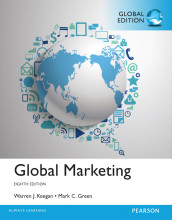Summary: Global Marketing, Global Edition | 9781292069555 | Warren J Keegan, et al
- This + 400k other summaries
- A unique study and practice tool
- Never study anything twice again
- Get the grades you hope for
- 100% sure, 100% understanding
Read the summary and the most important questions on Global Marketing, Global Edition | 9781292069555 | Warren J. Keegan; Mark C. Green
-
1 Introduction to Global Marketing
This is a preview. There are 3 more flashcards available for chapter 1
Show more cards here -
The terms 'Marketing' and 'Advertising' are related but are not completely the same. Can you explain the difference between these two terms?
- Marketing (to market).
- To place/establish a product on the market.
- Especially: Seeking to increase a product's sales through distribution and promotion strategies.
- Advertising.
- Generating visibility, attention, and engagement on some medium or platform.
- I.e., advertising is a method of marketing your product.
-
What are the six main drivers of global marketing?
- Technology.
- Internet and digital communication.
- Transportation & Logistics.
- Improved networks lower distribution costs.
- Trade agreements.
- Agreements like the EU or NAFTA.
- Market Needs.
- Similar consumer needs across countries.
- Cost Advantages.
- Economies of scale reduce production costs.
- Quality Standards.
- Global competition raises quality expectations.
- E.g., Heineken needs to taste the same on any place in the world.
- Technology.
-
4 Social and Cultural Environments
This is a preview. There are 2 more flashcards available for chapter 4
Show more cards here -
How does Geert Hofstede describe 'Culture' and which 7 components does he identify that shape it?
- Hofstede describes culture as the collective programming of the mind.
- Components that shape this collective programming:
- Attitudes.
- Beliefs.
- Values.
- Aesthetics.
- Religion.
- Diet.
- Communication and language.
- Hofstede describes culture as the collective programming of the mind.
-
Hofstede's model of Cultural Dimensions is one of the most effective tools we have to compare how cultural values influence behaviour across societies worldwide.Where does the data on which this model is based come from?
- The data is composed of employees who worked for IBM in 50 countries worldwide in the late 1960s and early 1970s.
- Uniformity: Because the corporate environment of IBM was very much uniform worldwide, it minimised differences in organisation culture which allowed Hofstede to focus on national cultural differences.
-
7 Segmentation, Targeting, and Positioning
This is a preview. There are 4 more flashcards available for chapter 7
Show more cards here -
To devise a marketing strategy, we often use a three step process. Which process are we referring to here and what are its three steps?
- STP-model.
- 3 steps of STP:
- Market Segmentation.
- Market Targeting.
- Product Positioning.
- STP-model.
-
10 Brands and Product Decisions in Global Marketing
This is a preview. There are 5 more flashcards available for chapter 10
Show more cards here -
What do we mean when we talk about the 'brand image'?
- The Brand Image is the sum of all impressions about a brand.
- A brand is a bundle of images and experiences in the mind of the customer.
- E.g., A promise made about a particular product.
- E.g., a quality certification.
- E.g., Differentiation between competing products.
- The Brand Image is the sum of all impressions about a brand.
-
One of the most important brand concepts is 'brand equity'. Can you explain what this term means and what its 7 greatest benefits are?
- Brand equity is the total value and strength of a brand that results from its relationship with customers over time.
- It makes a brand more than just a name or logo.
- It is the accumulation of the emotional, financial, and perceived value that a brand adds to a product or service.
- Benefits of brand equity:
- Greater loyalty.
- Less vulnerability to marketing actions.
- Less vulnerability to marketing crises.
- Larger margins.
- More inelastic consumer response to price increases.
- More elastic consumer response to price decreases.
- Increased marketing communication effectiveness.
- Brand equity is the total value and strength of a brand that results from its relationship with customers over time.
-
Can you elucidate the difference between an 'international product and brand' and a 'global product and brand'?
- International product and brand.
- Products and brands offeren in several markets in a particular region.
- E.g., Honda 5-door hatchback car is known as 'Fit' in Japan, but in Europe it's known as 'Jazz'.
- Global product and brand.
- Global products meet the wants and needs of a global market and are offered in all world regions.
- Global brands have the same name, image and (same/similar) positioning throughout the world.
- E.g., In any language Gilette's trademarked brand promise is: "Gilette, The Best a Man Can Get."
- International product and brand.
-
What are Brand Extensions?
- When a brand acts as an umbrella for new products.
- E.g,. Disney.
- Disney Pixar films.
- Disney+ streaming.
- Disneyland theme parks.
- Disney XD television channel.
- When a brand acts as an umbrella for new products.
-
15 Global Marketing and the Digital Revolution
This is a preview. There are 8 more flashcards available for chapter 15
Show more cards here -
What is the GDPR and how does it relate to digital marketing and the Digital Revolution.
- The GDPR is an abbreviation for: General Data Protection Regulation.
- It's an EU law that is mandatory for all companies doing business in the EU.
- It stems from concerns about who controls the internet.
- Policy makers and the public have privacy concerns about how Amazon, Meta, Google, and other tech giants gather information and big-data about their customers.
- The GDPR is an abbreviation for: General Data Protection Regulation.
- Higher grades + faster learning
- Never study anything twice
- 100% sure, 100% understanding
































